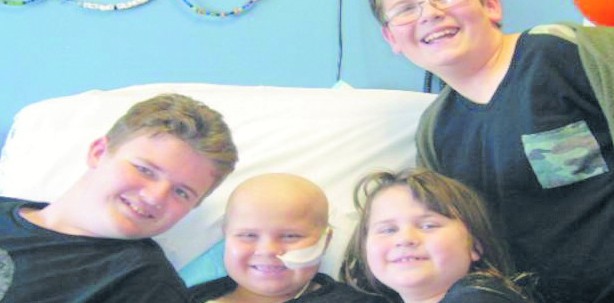by PETER GRACE
The journey of a sick young girl over more than 600 days has been one of uncertainty, of worry — and of faith, hope and love — for her family and her faith community.
In Emily Prince’s room in Starship Hospital in Auckland, her mother, Joanne, showed NZ Catholic her
daughter’s strings of beads taking up a large part of the wall behind her bed. Each colour represents a particular step on her journey through myelodysplasia (cancer of the bone marrow).
A bead of courage is added for each day. “She’s got 602 beads of courage,” Mrs Prince said on November
12. There are beads of mixed colours for rough days, red beads for blood transfusions, blue beads, and
many others.
The Prince family: Joanne, Craig and children Ben (13), Cameron (11), Hannah and Emily (7½, and identical twins) belong to St Joseph’s parish in Upper Hutt.
And Emily has been getting encouragement from her school, St Joseph’s. It is striking that in an hour in Emily’s hospital room, while Joanne soothes Emily’s sore tummy, there is no hint of “Why Emily?”, or “Why us?”. There is a sense of a deep “realness” — it is obvious Emily, and her family with her, is on
a hugely difficult journey — but there is quiet and warmth.
Drawings by children from Emily’s school in support of her are on hand. “It’s been a comfort knowing that the school’s been praying for her, as well,” said Mrs Prince. “The kids say, ‘We say A
Rosary for you each morning, Emily’… It’s so warming.”
Emily’s tummy is sore, Mrs Prince said, because her body is gradually eliminating medication. Because of this, she can’t eat and is on a liquefied diet.
They stay in a unit at Grafton Mews, in sight of Starship, and she and Craig alternate nights in Emily’s room.
The other three children go to school at Ronald McDonald House, near the hospital. A teacher works with Emily on days when she is up to it.
Emily had her bone marrow transplant on October 16.
They were lucky, Mrs Prince said, that all their children have a bone marrow tissue match. However, doctors decided to use bone marrow from Ben, because he is the eldest. It was empowering for Ben, knowing that his donation was important for his sister.
“It’s a very special gift,” Mr Prince said.
Mrs Prince said that in August 2012 Emily had her tonsils out, and they noticed bruises on her body. Then she started getting viral infections and was to and fro to the doctor three times in a few weeks.
“Then it was on Boxing Day two years ago — we had been to the river and walking on the stones, and that night we noticed all these bruises under her feet, turning a yellow colour.”
They took her to the doctor, who told them Emily needed blood tests. “And that’s when the journey started.”
They went to Hutt Hospital, then to Wellington Hospital. Emily had scans, x-rays, tests for auto-immune diseases, for hereditary diseases, “and all sorts of things”.
Samples of her bone marrow were sent overseas to several different labs.
“She got referred to Christchurch, where she had a series of operations and lumbar punches and things like that, and then they said they were going to refer her up to Starship.”
The family came to Auckland on December 18 last year and Emily had bone marrow aspiration — “and then
on December 20 at 11.15am the doctor said, ‘We finally have a diagnosis’,” said Mrs Prince.
They had a date in February this year for a bone marrow transplant, but that was put on hold.
Then her doctor from Christchurch and her doctor at Starship went to a medical conference in Prague, taking a sample of Emily’s bone marrow.
After conferring with an expert there, Emily was referred back to Auckland and they were given October
as the month for her transplant.
“It’s a rollercoaster, and they said, ‘Once you are on it, there are lots of ups and downs’.
“Now we are in the throes of it.”
After her transplant, Emily’s intravenous pole had eight bags of various kinds hanging from it.
“I think one of the saddest days was when they brought in a second pole,” Mrs Prince said.
By November 12, though, only one bag remained.
Their biggest worry now was infection and rejection [of the transplanted bone marrow], and continuing to be able to look after everyone’s needs.The transplant team hoped Emily would be able to leave the following week and recuperate for a month in Ronald McDonald House, Mr Prince said.
If there were no setbacks, they could be home by Christmas.
Otherwise, though, they would have Christmas at Ronald McDonald House with other families there, who
are bonded through the nature of they journeys they share.


Reader Interactions